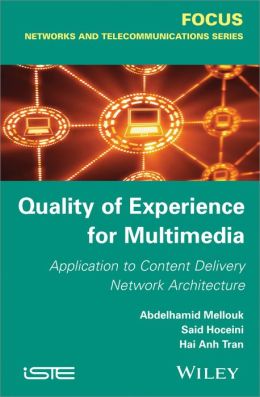 [内容简介]
[内容简介]
Based on a convergence of network technologies, the Next Generation Network (NGN) is being deployed to carry high quality video and voice data. In fact, the convergence of network technologies has been driven by the converging needs of end-users.
The perceived end-to-end quality is one of the main goals required by users that must be guaranteed by the network operators and the Internet Service Providers, through manufacturer equipment. This is referred to as the notion of Quality of Experience (QoE) and is becoming commonly used to represent user perception. The QoE is not a technical metric, but rather a concept consisting of all elements of a user's perception of the network services. The authors of this book focus on the idea of how to integrate the QoE into a control-command chain in order to construct an adaptive network system. More precisely, in the context of Content-Oriented Networks used to redesign the current Internet architecture to accommodate content-oriented applications and services, they aim to describe an end-to-end QoE model applied to a Content Distribution Network architecture.
[目录]
LIST OF FIGURES ix
PREFACE xiii
INTRODUCTION xv
CHAPTER 1. NETWORK CONTROL BASED ON SMART COMMUNICATION PARADIGM 1
1.1. Motivation 1
1.2. General framework 3
1.3. Main innovations 6
1.3.1. User perception metrics and affective computing 6
1.3.2. Knowledge dissemination 8
1.3.3. Bio-inspired approaches and control theory 9
1.4. Conclusion 10
CHAPTER 2. QUALITY OF EXPERIENCE 11
2.1. Motivation 11
2.2. QoE concept 12
2.3. Importance of QoE 14
2.4. QoE metrics 16
2.5. QoE measurement methods 20
2.6. QoS/QoE relationship 23
2.7. Impact of networking on QoE 26
2.7.1. Layered classification of impacts on QoE 26
2.7.2. Impact of user mobility on QoE 28
2.7.3. Impact of network resource utilization and management on QoE 29
2.7.4. Impact of billing and pricing 30
2.8. Conclusion 31
CHAPTER 3. CONTENT DISTRIBUTION NETWORK 33
3.1. Motivation 33
3.2. Routing layer 36
3.2.1. Routing in telecommunication network 36
3.2.2. Classical routing algorithms 37
3.2.3. QoS-based routing 38
3.3. Meta-routing layer 42
3.3.1. Server placement 43
3.3.2. Cache organization 45
3.3.3. Server selection 47
3.4. Conclusion 49
CHAPTER 4. USER-DRIVEN ROUTING ALGORITHM APPLICATION FOR CDN FLOW 51
4.1. Introduction 51
4.2. Reinforcement learning and Q-routing 53
4.2.1. Mathematical model of reinforcement learning 56
4.2.2. Value functions 57
4.3. Q-learning 60
4.4. Q-routing 61
4.5. Related works and motivation 62
4.6. QQAR routing algorithm 63
4.6.1. Formal parametric model 64
4.6.2. QQAR algorithm 65
4.6.3. Learning process 68
4.6.4. Simple use case-based example of QQAR 71
4.6.5. Selection process 78
4.7. Experimental results 79
4.7.1. Simulation setup 79
4.7.2. Experimental setup 89
4.7.3. Average MOS score 90
4.7.4. Convergence time 97
4.7.5. Capacity of convergence and fault tolerance 100
4.7.6. Control overheads 102
4.7.7. Packet delivery ratio 103
4.8. Conclusion 104
CHAPTER 5. USER-DRIVEN SERVER SELECTION ALGORITHM FOR CDN ARCHITECTURE 105
5.1. Introduction 105
5.2. Multi-armed bandit formalization 108
5.2.1. MAB paradigm 108
5.2.2. Applications of MAB 112
5.2.3. Algorithms for MAB 113
5.3. Server selection schemes 119
5.4. Our proposal for QoE-based server selection method 122
5.4.1. Proposed server selection scheme 122
5.4.2. Proposed UCB1-based server selection algorithm 125
5.5. Experimental results 126
5.5.1. Simulation results 126
5.5.2. Real platform results 132
5.6. Acknowledgment 133
5.7. Conclusion 135
CONCLUSION 137
BIBLIOGRAPHY 141
INDEX 155

 新书报道
新书报道